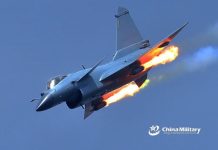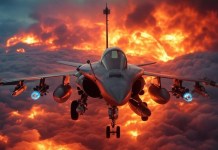The Pakistani government recently alleged that India will conduct another “surgical strike” to create a diversion from its internal issues. After the Indian Army and the Indian Air Force, is it time for the Indian Navy to take the baton?
In an exclusive interview with ANI, Defense Minister Rajnath Singh said that India has the capability to hit terrorist targets across the border if the need arises (referring to Pakistan without naming the country)
“The country`s soldiers have proved that not only this side, but to eliminate terrorism they can go to the other side and attack terrorist hideouts if the need arises. India has that capability, that power,” he said.
Apprehensive Pakistan
After Pakistani Foreign Minister SM Qureshi, Pakistan’s Prime Minister Imran Khan recently also reiterated his resolve to a “befitting response at all levels of the threat” if India carries-out a strike operation. He further called on the international community to warn of India’s actions.
“I want to again warn the world community, as India’s internal problems mount, especially economic recession, growing farmers protests & mishandling of COVID 19, the Modi govt will divert from the internal mess by conducting a false flag operation against Pakistan,” he said in a series of tweets.
“Already, in 2020 alone, there have been 3000 Indian ceasefire violations along the LoC & Working Boundary, by unprovoked firing deliberately targeting civilians – resulting in 276 casualties, of which 92 were women & 68 children,” he added.
I want to again warn the world community, as India's internal problems mount, especially economic recession, growing farmers protests & mishandling of COVID 19, the Modi govt will divert from the internal mess by conducting a false flag operation against Pakistan.
— Imran Khan (@ImranKhanPTI) December 20, 2020
I am making absolutely clear to the int community that if India was to be reckless enough to conduct a false flag operation against Pakistan, it would confront a strong national Pakistani resolve & be given a befitting response at all levels of the threat. Make no mistake.
— Imran Khan (@ImranKhanPTI) December 20, 2020
There has been no immediate response from the Indian side on the alleged plan of a surgical strike. However, Anurag Srivastava, the spokesman for the Ministry of External Affairs rejected claims that Indian defense forces targetted a UN vehicle along the Line of Control (LoC) in the Pakistan-administered Kashmir area.
“Instead of repeating baseless and fabricated allegations against India to cover up its own failure in ensuring the safety and security of UN personnel in territory under its control, Pakistan should responsibly investigate its lapses. India has conveyed its findings and views on these misrepresentations to the Pakistani side,” Srivastava said in a statement.
Indian Army
Indian defense forces successfully carried out two surgical strikes, one in 2016 and the other in 2019. Both the strikes were supposedly in response to the terror attacks that preceded the strikes.
On September 18, four heavily armed Jaish-e-Mohammed terrorists entered the Indian Army base in Uri in Kashmir and killed 19 Indian soldiers. This was reported as the “deadliest attack on security forces in Kashmir in two decades.”
On September 29, India announced that the army carried out a ground base surgical strike in Pakistan Administered Kashmir against the militant launch pads and inflicted “significant casualties.” Pakistan rubbished India’s claims and said that there were only border skirmishes.
Indian Air Force
In the early hours of February 26, 2019, India launched a ‘surgical strikes’ in Balakot when Indian warplanes crossed the border and dropped bombs claiming to have destroyed major terror training camps and infrastructure in Balakot, a claim vehemently rejected by Pakistan.
In retaliation, the very next day, Pakistan came dangerously close to attacking Indian military installations but refrained from provoking the Indians and dropped bombs nearby the facilities. However, the PAF managed to shoot-down a MiG-21 Bison in aerial combat besides capturing Indian Air Force (IAF) pilot Abhinandan Varthaman, who was handed over to India on March 1, 2019.
This strike was followed after the Pulwama terror attack on February 14, 2019, when a suicide bomber with a car laden with explosives hit an Indian Army convoy. The attack killed 40 Indian soldiers. The Jaish-e-Mohammed terror group took the responsibility for the attack.
Indian Navy?
After the Indian Army and the Air force, can the Indian Navy be the next to carry out a cross-border strike? Reportedly, after the Pulwama terror attack in 2019, all the three service branches drew out their operation plans.

Snehesh A Philip writing for The Print revealed earlier that the ops planned by the Indian Army was ruled out as the Pakistani army was on high alert after the terror attack, the Indian side losing the element of surprise.
Philip added that the Navy’s plans were dropped because the plan to hit Karachi, the financial capital, would have been perceived as an “act of war,” threatening an “international crisis.”
This time also, the Pakistan Army has been put on high alert following the “possible threat of a strike,” reported Dawn.
According to experts talking to the EurAsian Times, It highly unlikely India will use its Navy as New Delhi would like to take action across the LOC only and not on the International Border. So blocking Karachi port or other fancies is out of the question.
However, the Indian Navy could still be used for striking Pakistani terror targets. According to earlier reports, some of the MiG-29K jets of the Indian Navy were shifted from Goa to IAF bases in the north, keeping in mind the security scenario in the region.
The 4+ generation MiG-29K possesses a multi-function radar and hands-on-throttle-and-stick (HOTAS) controls. Along with air to air missiles, owing to the integration of RVV-AE, it also carries anti-ship and anti-radar operations and several surface precision-guided weapons.
Indian Navy’s P-8I surveillance aircraft were already carrying out numerous reconnaissance missions over Eastern Ladakh and could also be used for similar missions near the LOC.
“The aircraft has been specifically customized by the Indian armed forces in order to be adaptable to different surroundings. While their major role lies in the sea, they can work as an additional pair of eyes out in the Ladakh region, and assist in other missions when needed,” IAF expert stated
This is not the first time that the P-8I has been deployed for non-maritime operations. In 2017, it used to carry out battlefield surveillance and management roles during the 73-day Doklam standoff between Indian and PLA troops.
Earlier this year, Chief of Defense Staff, General Rawat, had explained how he got familiarized with the P-8I aircraft, which were also used in the aftermath of the 2019 Pulwama terror attack. “I came to know about the capabilities of the P-8I anti-submarine warfare planes after they were deployed in Doklam for surveillance,” said Rawat.
Follow EurAsian Times on Google News




